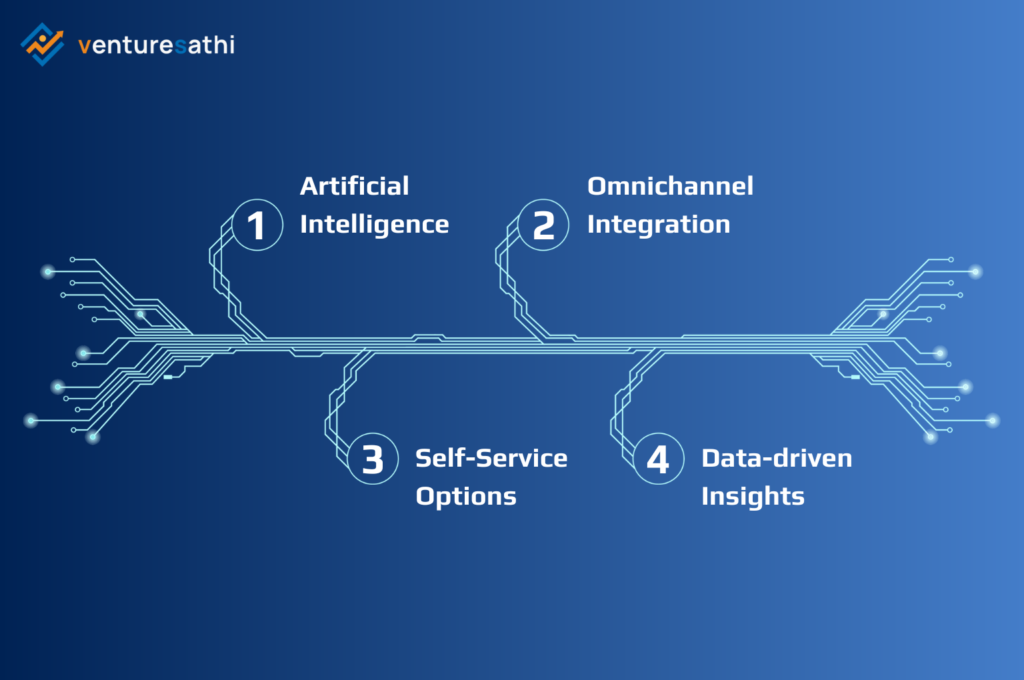Customer service technology is advancing rapidly, with AI tools like chatbots transforming how businesses interact with clients. As these innovations promise greater efficiency, the challenge becomes finding the right balance between AI and human agents.
Balancing AI and human agents is crucial for businesses to meet rising customer expectations. Effective integration of AI while preserving the personal touch of human interactions ensures exceptional service.
This article will examine the strengths and limitations of AI chatbots and human agents, offering insights into how they can work together. We’ll provide practical strategies for combining both to enhance your customer support operations.
Maximize every customer interaction by leveraging Venturesathi’s contact center services.
Artificial Intelligence vs. Human Intelligence
- Artificial Intelligence (AI): AI refers to technology miming human intelligence through sophisticated algorithms and data processing. It enables machines to perform tasks that typically require human intelligence, such as understanding language, recognizing patterns, and making decisions.
In customer service, AI often takes the form of chatbots, and virtual assistants designed to handle routine inquiries and automate processes.
Understanding the distinct roles of AI and human intelligence is key to optimizing customer service, with AI handling routine tasks and human agents providing emotional intelligence and problem-solving skills for a balanced strategy.
- Human Intelligence: This is the natural cognitive ability of humans to think, understand, learn, and interact with others. Human intelligence involves empathy, creativity, and complex problem-solving skills.

In customer service, human agents leverage these abilities to address nuanced issues, provide emotional support, and offer personalized solutions.
AI vs. Human Intelligence: How Can They Work Together?
Synergy Between AI and Human Agents:
- Complementary Strengths: AI efficiently handles repetitive tasks, like answering common questions or processing basic transactions. This frees up human agents to address complex and emotionally nuanced issues that require empathy and advanced problem-solving.
- Seamless Integration: AI provides valuable data and insights, helping human agents prioritize their efforts. This integration enhances workflows, allowing agents to focus on higher-value interactions and deliver more personalized support.
Hybrid Models:
- AI-Driven Support: AI-powered chatbots manage routine inquiries and initial interactions, improving response times and consistency. This setup streamlines the support process, ensuring quick and efficient handling of straightforward tasks.
- Human Oversight: For complex or sensitive issues, AI escalates queries to human agents who can offer tailored solutions. This human oversight maintains the quality of support, especially in situations requiring a personal touch.
Leveraging AI for routine tasks and human agents for complex interactions enhances efficiency, improves customer experience, and supports scalable growth with a balanced, hybrid approach.
Curious about the impact of voice-based GenAI on customer interactions? Dive into our detailed guide and stay ahead of the curve.
AI in Customer Support: Advantages and Disadvantages

Balancing AI’s speed, cost savings, and consistency with its limitations in handling complex queries and empathy is crucial for exceptional customer support. By integrating AI to complement human agents, clients can optimize operations and enhance overall satisfaction.
See how leading companies are leveraging voice-based GenAI to enhance customer service – read our article for practical insights.
Finding the Right Balance: The 80/20 Rule
Concept of the 80/20 Rule:
- 80% Efficiency from AI: The 80/20 Rule suggests that AI can manage up to 80% of customer support tasks efficiently. This includes handling routine and repetitive inquiries such as frequently asked questions (FAQs), order tracking, and general information requests. By automating these tasks, AI systems can significantly enhance efficiency and speed up response times, freeing up human agents to focus on more complex issues.
- 20% Human Expertise: The remaining 20% of customer interactions typically require the nuanced skills of human agents. This portion includes complex problem-solving, sensitive or emotionally charged interactions, and personalized support that AI is not equipped to handle effectively. Human agents bring empathy, creativity, and advanced problem-solving abilities to these situations, ensuring that customers receive high-quality service.
Implementation Strategies:
- Task Allocation: To effectively apply the 80/20 Rule, it is crucial to identify and allocate tasks between AI and human agents. Evaluate your customer support processes to determine which tasks can be efficiently managed by AI and which require human involvement. For example, routine inquiries and transactional tasks can be automated, while intricate issues or cases requiring empathy should be handled by skilled human agents.
- Escalation Paths: Develop clear escalation paths to ensure a smooth transition from AI to human agents when necessary. This involves setting up processes where AI can recognize when an issue is beyond its capabilities and seamlessly pass the interaction to a human agent. Effective escalation paths ensure that customers receive the appropriate level of support without delays or frustration.
Comparing the Limitations of AI and Human Agents

Understanding the limitations of both AI and human agents is essential for designing a balanced customer support system. By recognizing AI’s strengths and weaknesses, clients can strategically deploy AI for tasks where it excels, while also addressing its limitations through human oversight. Similarly, understanding the constraints of human agents allows for better management of training, consistency, and turnover issues. The goal is to create a support system that leverages the strengths of both AI and human agents, addressing their respective weaknesses to provide a comprehensive, effective, and efficient customer service experience.
Experience customer service reimagined – Venturesathi blends the best of customer service processes to elevate your brand.
EndNote
We explored the strengths and limitations of both AI chatbots and human agents in customer support. AI offers unparalleled speed, efficiency, and scalability, making it ideal for handling routine tasks and large volumes of inquiries. However, it struggles with complex queries, lacks emotional intelligence, and faces challenges with language variations. Human agents, on the other hand, provide empathy, handle intricate issues effectively, and offer personalized support. Yet, they come with challenges related to consistency, cost, and turnover.
Finding the right balance between AI and human support is crucial for creating an effective customer service strategy. By leveraging AI for efficiency and scalability while reserving human agents for complex and emotionally nuanced interactions, you can enhance your support system’s overall performance and customer satisfaction.


